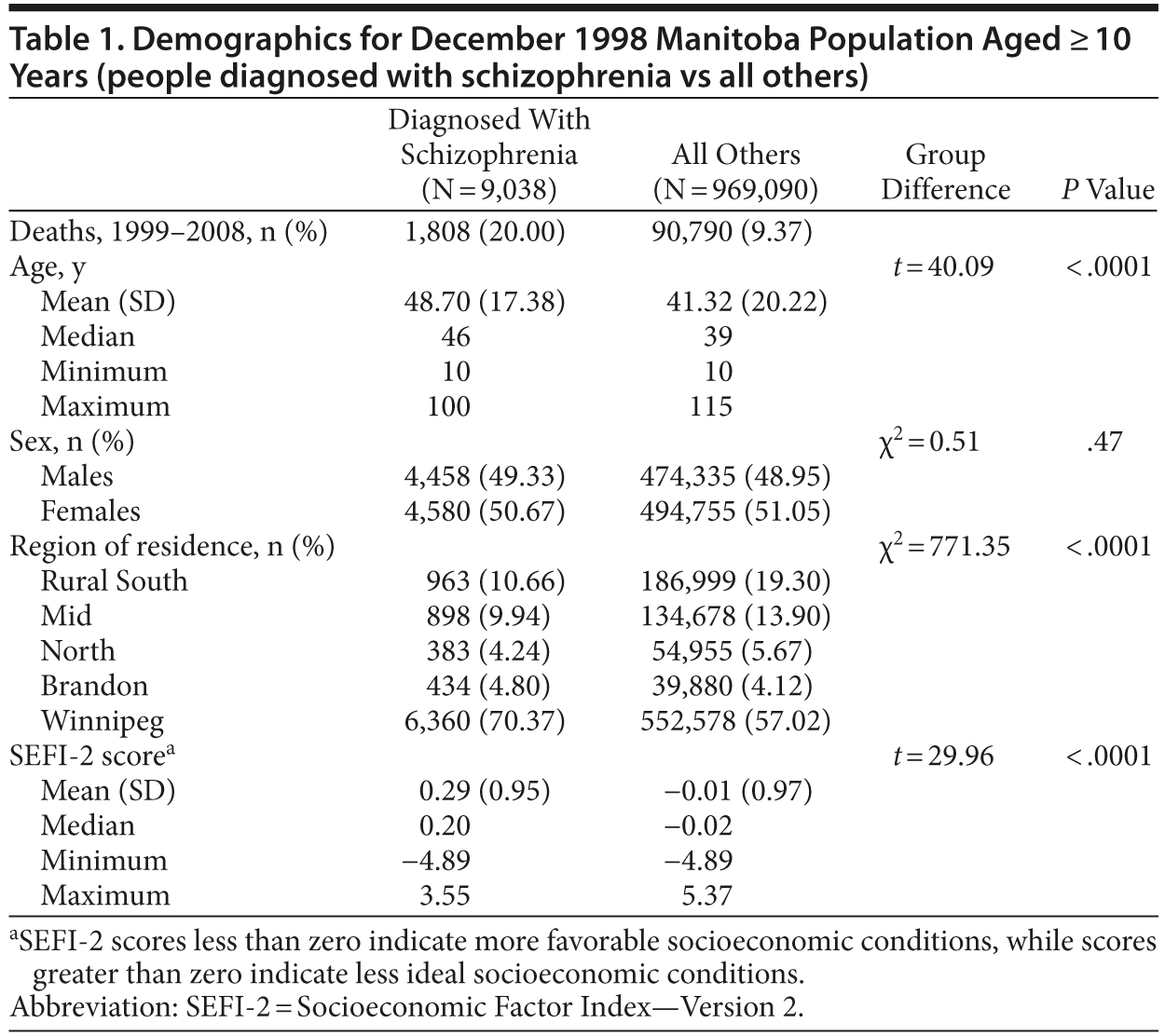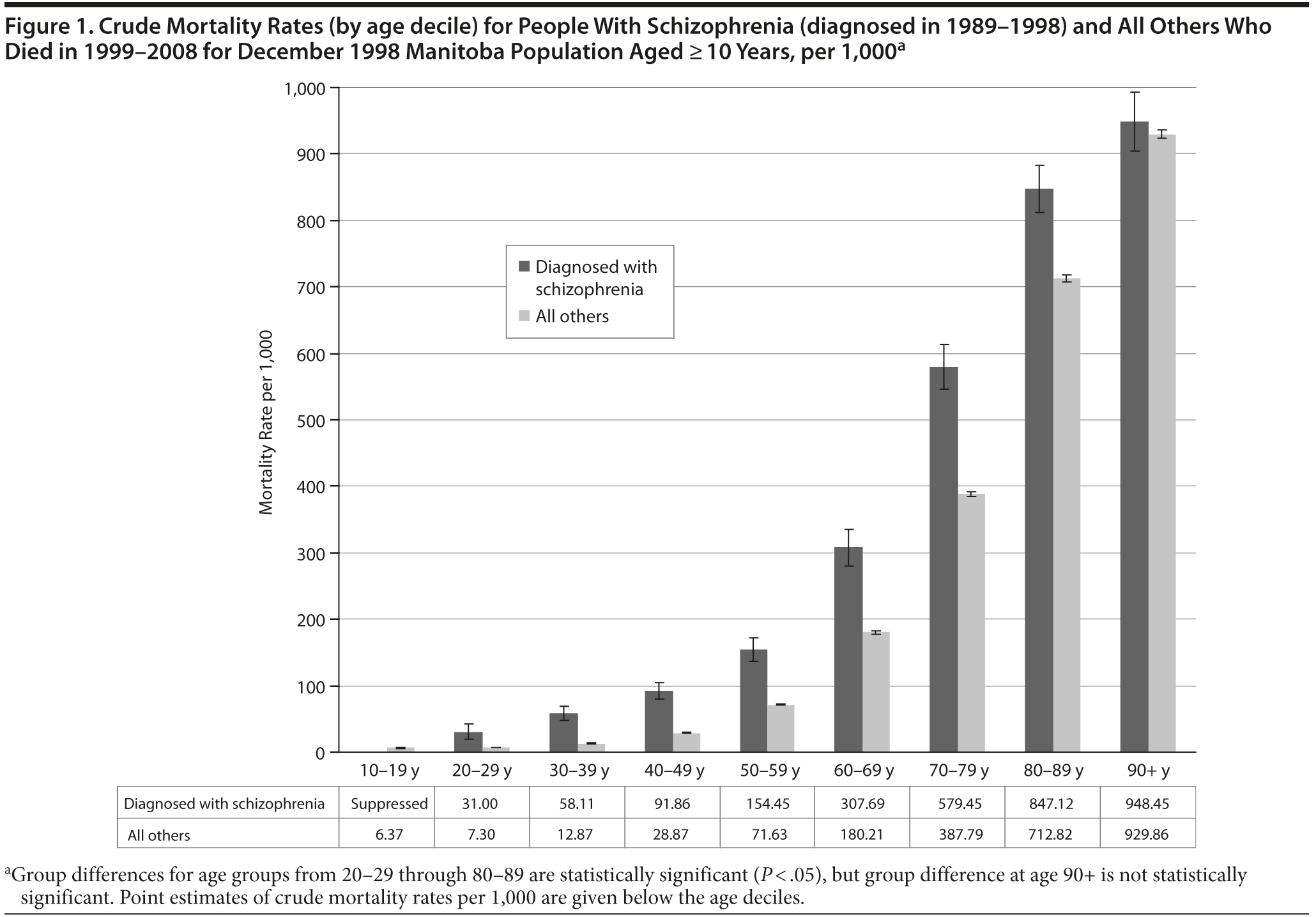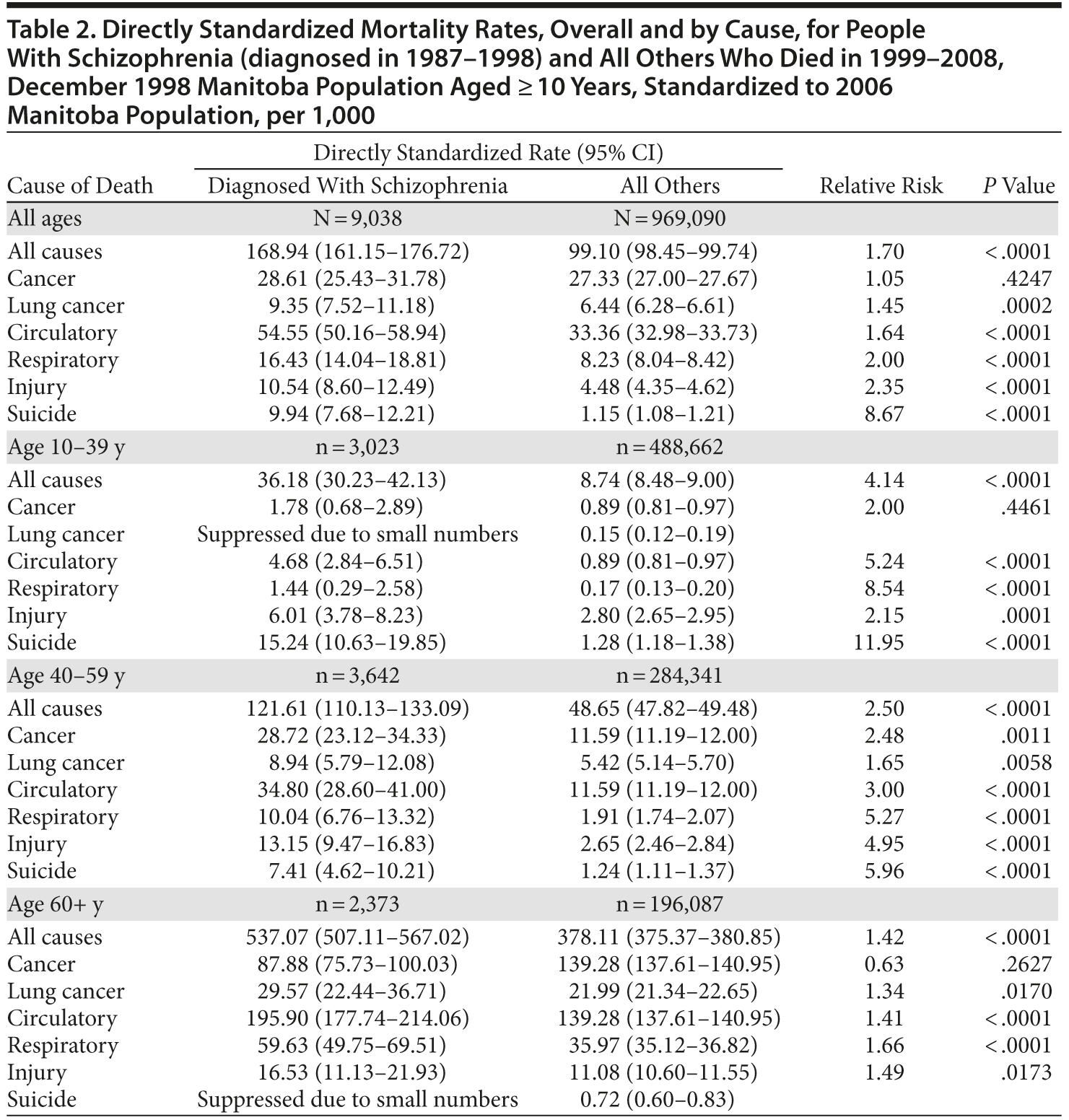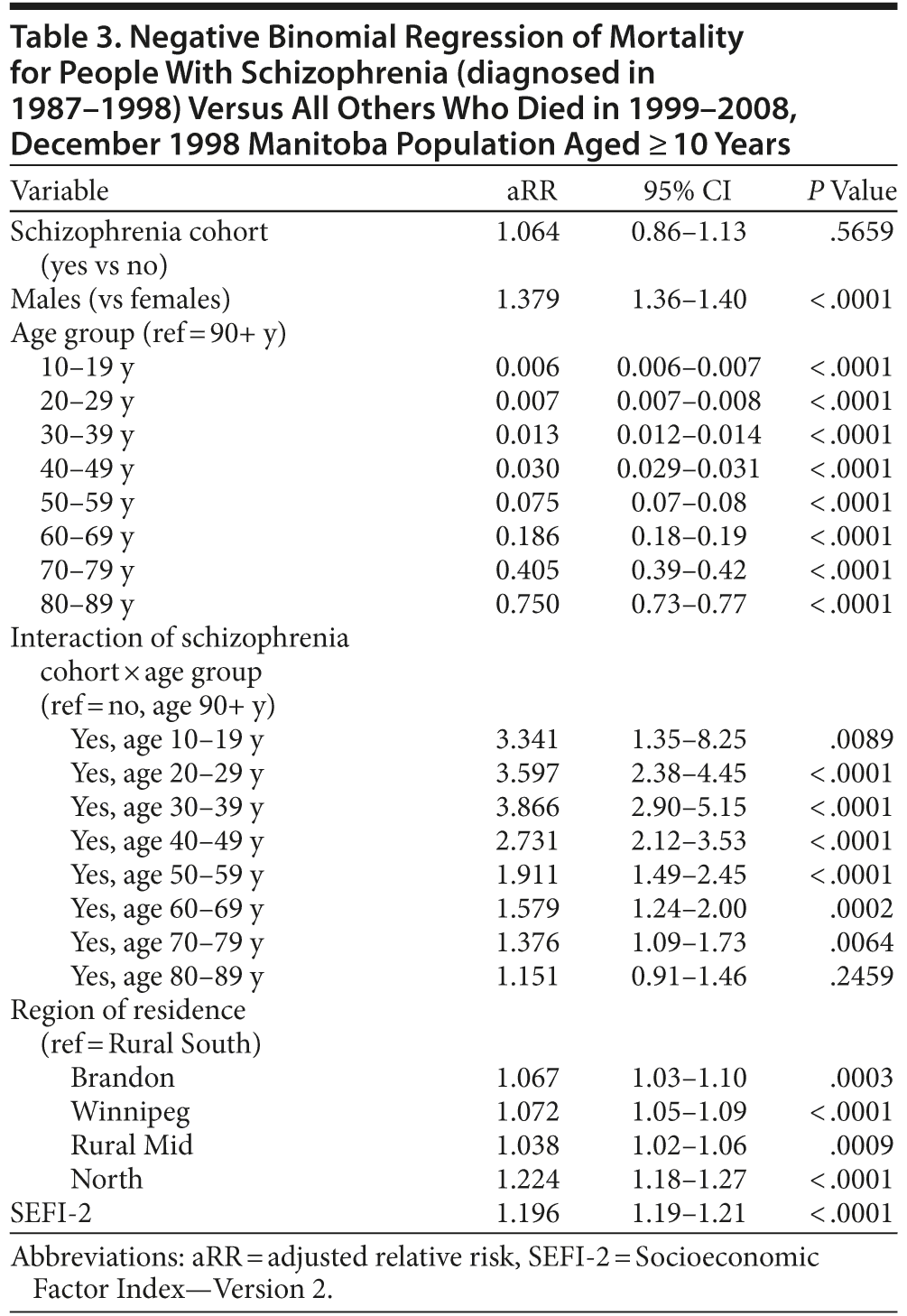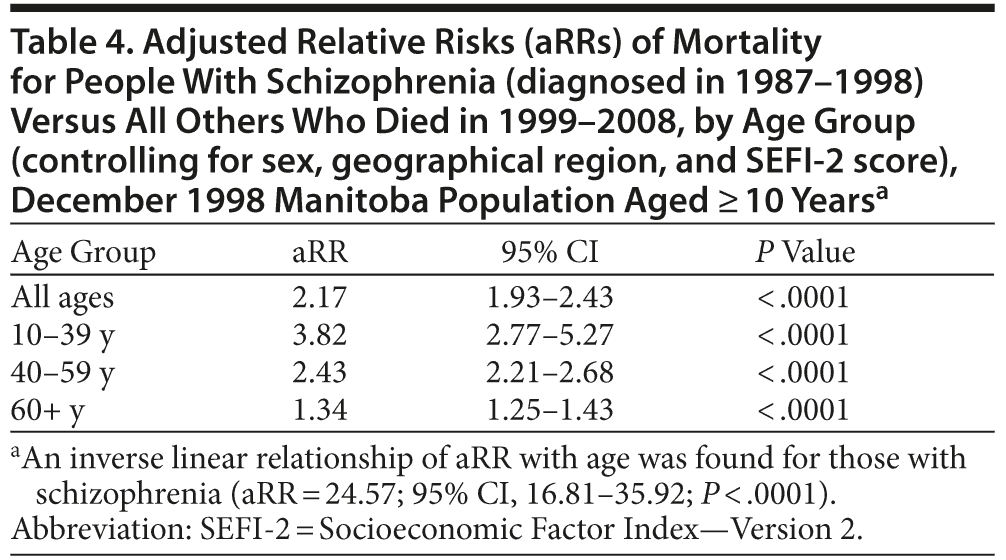ABSTRACT
Objective: To compare the causes and rates of death for people with and without schizophrenia in Manitoba, Canada.
Method: Using de-identified administrative databases at the Manitoba Centre for Health Policy, a population-based analysis was performed to compare age- and sex-adjusted 10-year (1999-2008) mortality rates, overall and by specific cause, of decedents aged 10 years or older who had 1 diagnosis of schizophrenia (ICD-9-CM code 295, ICD-10–CA codes F20, F21, F23.2, F25) over a 12-year period (N = 9,038) to the rest of the population (N = 969,090).
Results: The mortality rate for those with schizophrenia was double that of the rest of the population (20.00% vs 9.37%). The all-cause mortality rate was higher for people with schizophrenia compared to all others (168.9 vs 99.1 per thousand; relative risk [RR] = 1.70, P < .0001); rates of death due to suicide (RR = 8.67, P < .0001), injury (RR = 2.35, P < .0001), respiratory illness (RR = 2.00, P < .0001), and circulatory illness (RR = 1.64, P < .0001) were also significantly higher in people with schizophrenia. Overall cancer deaths were similar (28.6 vs 27.3 per thousand, P = .42, NS) except in the middle-aged group (40-59), in which cancer death rates were significantly higher for those with schizophrenia (28.7 vs 11.6 per thousand; RR = 2.48, P < .01). Mortality rates due to lung cancer were significantly higher in people with schizophrenia (9.4 vs 6.4 per thousand, RR = 1.45, P < .001).
Conclusions: People with schizophrenia are at increased risk of death compared to the general population, and the majority of these deaths are occurring in older age from physical disease processes. Risk of cancer mortality is significantly higher in middle-aged but not younger or older patients with schizophrenia. Understanding these patients’ vulnerabilities to physical illness has important public health implications for prevention, screening, and treatment as the population ages.
J Clin Psychiatry 2014;75(2):154-161
© Copyright 2014 Physicians Postgraduate Press, Inc.
Submitted: August 2, 2013; accepted November 7, 2013 (doi:10.4088/JCP.13m08711).
Corresponding author: Maia S. Kredentser, MSc, Manitoba Palliative Care Research Unit, 3017-675 McDermot Ave, Winnipeg, Manitoba, Canada R3E 0V9 ([email protected]).
Schizophrenia is a serious and chronic disorder, with prevalence between 0.5% and 2% of the general population.1-3 For individuals with schizophrenia, the literature indicates a pattern of excess mortality and comorbidity compared to the general population, a gap that appears to be widening.4 Those with schizophrenia are more likely to die prematurely5; however, evidence for the causes and mechanisms for this increased mortality has been mixed. Schizophrenia patients have increased risk for unnatural deaths from suicide and accidents, but ~ 60%-70% of excess mortality is due to other disease processes,2,6 with increased risk for cardiovascular disease, respiratory disorders, diabetes, tuberculosis, and other infectious diseases.1,7
From a socio-environmental perspective, elevated comorbidity rates may be attributable to marginalization of individuals with schizophrenia within the health care system. Patients with schizophrenia are more likely to die in nursing homes8 and are less likely to receive preventative screening for physical illnesses such as breast and cervical cancer.9,10 They are more likely to be socially isolated,11-13 experience disproportionate rates of poverty and homelessness,14,15 and can feel disenfranchised and vulnerable in the health care system.16 These risk factors are associated with a host of behavioral risk factors including an approximately 4 times higher rate of cigarette smoking,17,18 use of licit and illicit drugs,19 poor diet, and lack of exercise.17 Environmental and behavioral risk factors are further complicated by the side effects of psychotropic medications, including obesity, metabolic syndrome, and cardiovascular risk.5,20,21
Despite the compelling evidence for increased mortality in schizophrenia related to many physical illnesses, there have been conflicting findings in regard to cancer deaths. Some research indicates schizophrenia is associated with reduced cancer risk, suggesting possible genetic factors that suppress tumors, and protective factors of psychotropic medications.4,22,23 Some evidence suggests that men with schizophrenia are at reduced risk while women are at increased risk for developing cancer24; however, others have found increased cancer mortality for both sexes with schizophrenia, particularly, increased mortality from breast cancer for women and lung cancer for men.3 In a matched-cohort study7 of decedents with and without schizophrenia, the percentage of deaths due to all cancers in the schizophrenia cohort was half that of the matched cohort, but the percentage of attributable lung cancer deaths was significantly higher in those with schizophrenia compared to the matched cohort. Race may also play a role, with reported incidence ratios of cancer risk higher in Asian cohorts of patients with schizophrenia compared to their European counterparts, although this difference may be attributable to lower baseline cancer rates in Asia.25,26 In terms of age effects, the all-cause rate of death in schizophrenia is 3 times higher than that of the general population, and mortality from neoplasms is twice as high.27 Thus, research into cancer and schizophrenia is well served by taking into account “age-specific risk” rather than examining lifetime incidence of cancer.25
The disparate findings regarding cancer in schizophrenia highlight the importance of considering the underlying population-based rates of cause of death. Mortality rates in schizophrenia are reported at 2 to 3 times higher than in the general population.7,27 However, cohort designs, including our previous work examining the percentage of attributable deaths in patients with schizophrenia,7 cannot account for the underlying population rates of death. In addressing this issue, the present study applied a decade-chronological perspective across the life trajectory of Manitoba residents. Manitoba is a prairie province located in the geographical center of Canada, with a population of 1.235 million. The objectives of this study were to compare the mortality rate and cause of death for people with and without schizophrenia. This population-based study included all people residing in Manitoba in 1998, comparing death rates over the 10-year period of 1999-2008, overall and by cause, of people with and without a diagnosis of schizophrenia.

- Patients with schizophrenia have increased risk of mortality from physical illness compared to the general population.
- Cancer mortality risk in middle age for those with schizophrenia is higher than that of the general population.
- Due to high illness and mortality rates, patients with schizophrenia require continuity of care to enhance preventative, curative, and palliative treatment efforts.
METHOD
This study used de-identified administrative claims data from the Population Health Research Data Repository (herein referred to as the Repository) housed at the Manitoba Centre for Health Policy (MCHP), University of Manitoba, in Winnipeg, Canada. The Repository data files include de-identified records of all hospital claims, medical claims for ambulatory physician visits, registry files (records of the person’s demographic information—age, sex, 6-digit postal code of residence, birth and death dates), and vital statistics (cause of death) for those registered under the universal health care system for the province of Manitoba. Ethnographic information is not available through the repository. Although the data are de-identified, they are linkable at the person level through an encrypted personal health number once ethics and health information privacy approvals are obtained. People 10 years and older diagnosed with schizophrenia were defined as those having at least 1 diagnosis code for schizophrenia (ICD-9-CM code 295, ICD-10–CA [Canadian Enhancement of ICD-10]28 codes F20, F21, F23.2, F25) over a 12-year period, defined for the population-based analysis as the years 1987-1998. Crude and directly standardized 10-year mortality rates (calendar years 1999-2008) overall and by specific cause for people 10 years and older with schizophrenia (N = 9,038) were compared to rates for the rest of Manitobans (N = 969,090). Age was recorded as of December 1998; cause of death was coded using ICD-9 and ICD-10 (as of January 1, 2000), and rates were directly standardized to the 2006 provincial population. All rates based on 1 to 5 events are suppressed for confidentiality.
A generalized linear model with a negative binomial distribution tested the relationship of mortality rates by age, sex, diagnosis of schizophrenia, Socioeconomic Factor Index—Version 2 (SEFI-2) score,29 and geographical area of residence. SEFI-2 reflects underlying social determinants of health and includes the following Census-derived variables: average household income, percentage of single-parent households, unemployment rate, and high school graduation rate.29 Geographical area of residence was divided into 5 regions of the province—the 2 urban areas of Winnipeg and Brandon, and the Rural South, Mid, and North areas of the province. In 2010, over half (N = 683,100) of Manitoba residents lived in the capital city of Winnipeg, and 52,550 lived in the next largest urban center of Brandon.30,31
RESULTS
Rates of Death Overall and by Cause, Using a Population-Based Cohort From 1998 Followed Over 10 Years (1999-2008)
Table 1 shows the demographics of our population-based cohort as of December 1998, comparing number and percentage of deaths, age, sex, region of residence, and SEFI-2 scores for those with and without schizophrenia. In the 10-year period of 1999-2008, the mortality rate of people with schizophrenia was just over double that of the general population; 20.00% compared to 9.37%, respectively. The schizophrenia sample was older, was more likely to live in urban as compared to rural areas, and had less favorable socioeconomic conditions. The prevalence of schizophrenia in our sample is 0.92%, consistent with Canadian population norms.32
Figure 1 compares the crude rates of death of all Manitobans aged 10 and older with schizophrenia (N = 9,038) to those without schizophrenia (N = 969,090) over the 10-year time period 1999-2008, by various age groupings as of December 1998. At every age group except the oldest category (90+), there is a significant elevated mortality rate for people with schizophrenia.
Table 2 shows the age- and sex-adjusted mortality rates, with the all-cause mortality rate substantially higher for people with schizophrenia compared to all others (168.9 vs 99.1 per thousand, relative risk [RR] = 1.70, P < .0001); rates of death due to suicide (RR = 8.67, P < .0001), injury (RR = 2.35, P <.0001), respiratory illness (RR = 2.00, P <.0001), circulatory illness (RR = 1.64, P < .0001),and lung cancer (RR = 1.45, P < .001) were also significantly higher in the former versus latter. While overall cancer deaths were similar (28.6 vs 27.3 per thousand, RR = 1.05, NS), mortality rates due to lung cancer were significantly higher in people with schizophrenia (9.4 vs 6.4 per thousand, RR = 1.45, P < .001). Table 2 also shows higher all-cause mortality rates for schizophrenia across all age groups (ages 10-39, RR = 4.14, P < .001; ages 40-59, RR = 2.50, P < .001; age 60+, RR = 1.42, P < .001), with similar by-cause findings. However, combined cancer death rates were not significantly different between the groups aged 10-39 and 60+, but were almost 2.5 times higher for people aged 40-59 years with schizophrenia (28.7 vs 11.6 per thousand; RR = 2.48, P < .01). For lung cancer specifically, death rates for both the 40-59 and 60+ age groups were significantly higher for people with schizophrenia compared to all others (ages 40-59, 8.9 vs 5.4 per thousand, RR = 1.65, P < .01; age 60+, 29.6 vs 22.0 per thousand, RR = 1.34, P < .05) (lung cancer rates for ages 10-39 in the schizophrenia cohort were suppressed due to small numbers).
To summarize, by age group, people with schizophrenia aged 10-39 had an over 5 times greater risk of death from circulatory causes, an over 8 times greater risk of death from respiratory causes, and an almost 12 times greater risk of death from suicide compared to all others (see Table 2). Relative risk of death from these causes remains significantly higher than that of the general population at ages 40-59, albeit lower compared to the schizophrenia patients aged 10-39 (ie, those aged 40-59 had 3 times greater risk of death from circulatory causes, just over 5 times greater risk of death from respiratory causes, and almost 6 times greater risk of death from suicide compared to all others).
In the oldest age group of 60+ years, relative risk of dying from every cause other than suicide and cancer continues to be higher for those with schizophrenia. However, we see the gap in risk decline, with a 1.41 times greater risk of dying from circulatory causes and 1.66 times greater risk of dying from respiratory causes. There was a 1.49 times greater risk of death by injury for those with schizophrenia compared to the general population, but the number of suicides in the schizophrenia group was too low to conduct comparative analysis of risk with the general population. Overall, adults with schizophrenia 60 years or older have a relative risk of death from all causes that is 1.42 times higher than that of the non-schizophrenia group.
Regression modeling including age, sex, geographical region, and SEFI-2 score (Table 3) resulted in the following adjusted relative risks (aRRs) of mortality, comparing those with schizophrenia to the rest of the population by age (see Table 4): overall aRR (all ages) = 2.17 (95% CI, 1.93-2.43; P < .0001), ages 10-39, aRR = 3.82 (95% CI, 2.77-5.27; P < .0001); ages 40-59, aRR = 2.43 (95% CI, 2.21-2.68; P < .0001); age 60+, aRR = 1.34 (95% CI, 1.25-1.43; P < .0001). These further adjustments show only slightly truncated values compared to the age- and sex-adjusted rates only.
DISCUSSION
Across all age groups, all-cause mortality was significantly higher in individuals with schizophrenia, with the relative risk of death higher from suicide, injury, respiratory and circulatory illness, and lung cancer, but not all cancers combined. Increased all-cause and by-cause mortality for those with schizophrenia across age groups is consistent with previous research, showing elevated mortality in schizophrenia from both natural and unnatural causes.4
The age decile analysis was illuminating in the complicated picture of cancer mortality in schizophrenia. Compared to all others, individuals aged 40-59 with schizophrenia were at 1.65 times greater risk of death from lung cancer; in the 60+ age group, those with schizophrenia were at 1.34 times greater risk of death from lung cancer. Increased lung cancer mortality in schizophrenia has been ascribed to high rates of smoking in this population3,26,32,33 and is consistent with reported higher incidence of and death by lung cancer for both male and female patients with schizophrenia.26,33
When all age groups were collapsed, the relative risk of cancer mortality was not significantly different between those with and without schizophrenia, in line with previous research reporting no difference in standardized incidence ratios (SIRs) for all cancers in those with schizophrenia compared to those without.26 Standardized mortality ratios (SMRs) for a variety of causes of mortality in people with schizophrenia show that the median SMR for neoplasms indicated 37% more cases of death from neoplasms in those with schizophrenia than would be expected in the general population.4 However, this median SMR was quite low compared to mortality from other causes such as suicide, respiratory diseases, and infectious diseases. Whether schizophrenia is a risk or protective factor for the development of cancer has been extensively researched, but there continue to be inconsistent findings.25 Ji and colleagues24 examined cancer risk both before and after schizophrenia diagnosis, showing that before diagnosis, those with schizophrenia have lower SIRs for cancer risk compared to the general population, but after diagnosis, the SIR was equal to that of the general population, and increased when looking at women specifically. Such findings highlight the importance of examining cancer risk and mortality in schizophrenia across the illness course and the lifespan.25
Considering age in cancer mortality in schizophrenia is essential in furthering our understanding of risk and underlying rates of death.7,33 In our sample, those with schizophrenia were significantly older than the non-schizophrenia group, which may be due to the relatively few very young people (eg, under age 15) diagnosed with schizophrenia. In conducting further analysis by age group comparing those with schizophrenia to all others, we found that cancer mortality was 2.5 times higher in people 40-59 years of age with schizophrenia, with no significant difference in cancer mortality in the younger (10-39) and older (60+) age groups. This may be because cancer is a relatively rare event in younger people and is most often diagnosed in adults over the age of 60.33 While 85% of people with schizophrenia experience illness onset before age 45, the prevalence of schizophrenia in adults over the age of 55 is expected to double in the next 2 decades as the general population ages.34 Taken with our finding of elevated risk for cancer mortality in 40- to 59-year-olds with schizophrenia, health care systems and providers will need to adapt, increasing screening and treatment for this group, who face many barriers to receiving adequate health care at all stages of illness.6-9,13,14,35-37 The reality of increased rates of death from natural causes in middle and old age has important implications for the care of persons with serious mental illness.
The strength of this study is its population-based analysis, accounting for the underlying general mortality rates and prevalence of diagnoses across a large number of residents spanning various age groups. The ability to control for underlying population-based rates for cause of death adds important context to deaths reported in matched-cohort studies, which do not take into account the underlying rate of death and thus cannot demonstrate relative risks of death by diagnosis.8 Examining cancer risk in schizophrenia by age has recently been suggested as a way to better understand the complicated cancer-schizophrenia relationship,25 and the present study provides new and important information regarding cancer mortality using population-based analyses across age groups. There are benefits and limitations to using administrative claims data in the Repository at MCHP. The coding of schizophrenia in the Repository is highly reliable and valid, particularly in comparison to the diagnoses of other mental illness, and is supported by previous research.8-10,38 However, “cause of death” coding through the Manitoba government’s Department of Vital Statistics is a limitation, insofar as in Manitoba we are limited to 1 (primary) cause of death. If the primary cause of death (as coded by the attending physician or provincial coroner) is general or misleading (eg, “death by mental illness”), having additional coded causes of death would be useful.8 The Repository also contains data from Manitobans only, which may limit generalizability of our findings. However, we expect that this would be mitigated due to universal health care coverage across the other 9 provinces in Canada. Use of the Repository also limited our ability to assess the various determinants of the causes of mortality often implicated in schizophrenia, such as smoking behavior, weight, and comorbid illness symptoms (eg, blood-sugar levels). Recent research in the US Veteran population has shown that schizophrenia is associated with increased mortality risk even when adjusted for comorbidity, obesity, smoking, and exercise.2 Controlling for these additional markers in future research would provide helpful information for understanding physical illness and mortality in schizophrenia.
CONCLUSION
Contrary to the idea that those with serious mental illness die young from traumatic events, our study highlights that individuals with schizophrenia are getting old and getting sick, with rates of mortality significantly higher in every age group from 20 to 89. This echoes previous research by our group indicating a median age of death of 77 years in a population-based cohort of Manitobans with schizophrenia.8 While accidental death is a prominent cause of death in those under the age of 39 and, indeed, the highest rates of death in those with schizophrenia aged 10-39 in our sample were the result of injury or suicide, these causes represented the lowest death rates (compared to other causes) in those with schizophrenia aged 60 or older. For middle-aged and older adults, the risk of dying from most causes is significantly higher for those with schizophrenia. In middle age, there is a significantly higher risk of dying from cancers, but this risk is not significantly different in younger and older age groups.
That a majority of individuals with schizophrenia are living into old age and, for the most part, are dying of physical illness at significantly higher rates than those without schizophrenia has public health implications. Coordination of care is poor for patients with serious mental illness.1 Primary care for those with schizophrenia must include careful monitoring for respiratory and circulatory illness at all ages, and lung cancer in middle age. Conscious efforts by health care providers to reach out to marginalized patients can improve the situation. Among veterans in the United States with serious mental illness, those who dropped out of care but returned after being contacted by Veterans Affairs (VA) services for follow-up had an almost 6 times lower mortality rate than those patients who did not return.39 At the end of life, individuals with schizophrenia are less likely to see specialists, less likely to have pain controlled, and more likely to die in institutional settings.8 Yet, research examining end-of-life care in those with schizophrenia and cancer in highly integrated care settings, such as VA in the United States, shows comparable or better care than in those without mental illness.40 Such findings speak to the importance of continuity of care in schizophrenia, involving extensive interprofessional and intraprofessional collaboration in medical, psychiatric, and social services. Sensitivity and advocacy by health care providers to the vulnerability and unique needs of this population are important first steps in ensuring quality preventative, curative, and palliative care.
Disclosure of off-label usage: The authors have determined that, to the best of their knowledge, no investigational information about pharmaceutical agents that is outside US Food and Drug Administration-approved labeling has been presented in this article.
Author affiliations: Department of Psychology, Faculty of Graduate Studies (Ms Kredentser); Manitoba Centre for Health Policy, Department of Community Health Sciences, Faculty of Medicine (Dr Martens and Ms Prior); and Department of Psychiatry, Faculty of Medicine (Dr Chochinov), University of Manitoba, Winnipeg, Manitoba, Canada.
Financial disclosure: Mss Kredentser and Prior and Drs Martens and Chochinov have no personal affiliations or financial relationships with any commercial interest to disclose relative to the article.
Funding/support: This work was supported by funding from the University of Manitoba (Centre on Aging and Department of Psychology) (Ms Kredentser); the Canadian Institutes of Health Research (CIHR) (Drs Martens and Chochinov); the Public Health Agency of Canada (PHAC) CIHR/PHAC Applied Public Health Chair (Dr Martens); and a Canada Research Chair in Palliative Care (Dr Chochinov).
Acknowledgments: The authors are indebted to Manitoba Health and the Office of Vital Statistics in Manitoba Healthy Living, Seniors, and Consumer Affairs for the provision of data.
Additional information: The Population Health Research Data Repository is housed at the Manitoba Centre for Health Policy (MCHP) at the University of Manitoba, and owned by the Province of Manitoba. The database is individual or service-level data housed in a de-identified form at MCHP. Access to the data is restricted to individuals that have appropriate approvals from the province of Manitoba (Health Information Privacy Committee) and the University Research Ethics Board. It is not available externally. For more information regarding access or use of the data, contact Charles Burchill (telephone: 204-789-3429), Associate Director Data Access and Use, MCHP. Policy and procedure for access and use of the Repository can be found on the University of Manitoba’s MCHP Web site: http://umanitoba.ca/faculties/medicine/units/community_health_sciences/departmental_units/mchp/.
REFERENCES
1. Casey DA, Rodriguez M, Northcott C, et al. Schizophrenia: medical illness, mortality, and aging. Int J Psychiatry Med. 2011;41(3):245-251. PubMed doi:10.2190/PM.41.3.c
2. Chwastiak LA, Rosenheck RA, Desai R, et al. Association of psychiatric illness and all-cause mortality in the National Department of Veterans Affairs Health Care System. Psychosom Med. 2010;72(8):817-822. PubMed doi:10.1097/PSY.0b013e3181eb33e9
3. Tran E, Rouillon F, Loze JY, et al. Cancer mortality in patients with schizophrenia: an 11-year prospective cohort study. Cancer. 2009;115(15):3555-3562. PubMed doi:10.1002/cncr.24383
4. Saha S, Chant D, McGrath J. A systematic review of mortality in schizophrenia: is the differential mortality gap worsening over time? Arch Gen Psychiatry. 2007;64(10):1123-1131. PubMed doi:10.1001/archpsyc.64.10.1123
5. Lahti M, Tiihonen J, Wildgust H, et al. Cardiovascular morbidity, mortality and pharmacotherapy in patients with schizophrenia. Psychol Med. 2012;42(11):2275-2285. PubMed doi:10.1017/S0033291712000396
6. Foti ME. Palliative care for patients with serious mental illness. In: Chochinov HM, Breitbart W, eds. Handbook of Psychiatry in Palliative Medicine. 2nd ed. New York, NY: Oxford University Press; 2009:113-121.
7. Martens PJ, Chochinov HM, Prior HJ. Where and how people with schizophrenia die: a population-based, matched cohort study in Manitoba, Canada. J Clin Psychiatry. 2013;74(6):e551-e557. PubMed doi:10.4088/JCP.12m08234
8. Chochinov HM, Martens PJ, Prior HJ, et al. Comparative health care use patterns of people with schizophrenia near the end of life: a population-based study in Manitoba, Canada. Schizophr Res. 2012;141(2-3):241-246. PubMed doi:10.1016/j.schres.2012.07.028
9. Martens PJ, Chochinov HM, Prior HJ, et al; Need To Know Team. Are cervical cancer screening rates different for women with schizophrenia? a Manitoba population-based study. Schizophr Res. 2009;113(1):101-106. PubMed doi:10.1016/j.schres.2009.04.015
10. Chochinov HM, Martens PJ, Prior HJ, et al; Need To Know Team. Does a diagnosis of schizophrenia reduce rates of mammography screening? a Manitoba population-based study. Schizophr Res. 2009;113(1):95-100. PubMed doi:10.1016/j.schres.2009.04.022
11. Lawrence D, Kisely S. Inequalities in healthcare provision for people with severe mental illness. J Psychopharmacol. 2010;24(suppl):61-68. PubMed doi:10.1177/1359786810382058
12. Pollio DE, North CS, Osborne VA. Family-responsive psychoeducation groups for families with an adult member with mental illness: pilot results. Community Ment Health J. 2002;38(5):413-421. PubMed doi:10.1023/A:1019812512926
13. Foti ME, Bartels SJ, Van Citters AD, et al. End-of-life treatment preferences of persons with serious mental illness. Psychiatr Serv. 2005;56(5):585-591. PubMed doi:10.1176/appi.ps.56.5.585
14. Song J, Bartels DM, Ratner ER, et al. Dying on the streets: homeless persons’ concerns and desires about end of life care. J Gen Intern Med. 2007;22(4):435-441. PubMed doi:10.1007/s11606-006-0046-7
15. McCasland LA. Providing hospice and palliative care to the seriously and persistently mentally ill. J Hospice Palliat Nurs. 2007;9(6):305-313. doi:10.1097/01.NJH.0000299313.99514.0c
16. Tarzian AJ, Neal MT, O’ Neil JA. Attitudes, experiences, and beliefs affecting end-of-life decision-making among homeless individuals. J Palliat Med. 2005;8(1):36-48. PubMed doi:10.1089/jpm.2005.8.36
17. Goff DC, Cather C, Evins AE, et al. Medical morbidity and mortality in schizophrenia: guidelines for psychiatrists. J Clin Psychiatry. 2005;66(2):183-194, quiz 147, 273-274. PubMed doi:10.4088/JCP.v66n0205
18. Kelly DL, McMahon RP, Wehring HJ, et al. Cigarette smoking and mortality risk in people with schizophrenia. Schizophr Bull. 2011;37(4):832-838. PubMed doi:10.1093/schbul/sbp152
19. Mackowick KM, Heishman SJ, Wehring HJ, et al. Illicit drug use in heavy smokers with and without schizophrenia. Schizophr Res. 2012;139(1-3):194-200. PubMed doi:10.1016/j.schres.2012.04.012
20. Joukamaa M, Heliövaara M, Knekt P, et al. Schizophrenia, neuroleptic medication and mortality. Br J Psychiatry. 2006;188(2):122-127. PubMed doi:10.1192/bjp.188.2.122
21. Laursen TM, Munk-Olsen T, Nordentoft M, et al. Increased mortality among patients admitted with major psychiatric disorders: a register-based study comparing mortality in unipolar depressive disorder, bipolar affective disorder, schizoaffective disorder, and schizophrenia. J Clin Psychiatry. 2007;68(6):899-907. PubMed doi:10.4088/JCP.v68n0612
22. Lawrence D, Kisely S, Pais J. The epidemiology of excess mortality in people with mental illness. Can J Psychiatry. 2010;55(12):752-760. PubMed
23. Bushe CJ, Hodgson R. Schizophrenia and cancer: in 2010 do we understand the connection? Can J Psychiatry. 2010;55(12):761-767. PubMed
24. Ji J, Sundquist K, Ning Y, et al. Incidence of cancer in patients with schizophrenia and their first-degree relatives: a population-based study in Sweden. Schizophr Bull. 2013;39(3):527-536. PubMed doi:10.1093/schbul/sbs065
25. Chen Y-J, Lin G-M, Li Y-H. Cancer risk before schizophrenia diagnosis in Taiwan, 1995-2009. Schizophr Bull. 2013;39(4): 729-731. PubMed
26. Catts VS, Catts SV, O’ Toole BI, et al. Cancer incidence in patients with schizophrenia and their first-degree relatives: a meta-analysis. Acta Psychiatr Scand. 2008;117(5):323-336. PubMed doi:10.1111/j.1600-0447.2008.01163.x
27. Talaslahti T, Alanen HM, Hakko H, et al. Mortality and causes of death in older patients with schizophrenia. Int J Geriatr Psychiatry. 2012;27(11):1131-1137. PubMed doi:10.1002/gps.2833
28. Canadian Institute for Health Information. The Canadian Enhancement of ICD-10. Final Report. http://www.gov.mb.ca/health/population/2010/pr2010.pdf. Published June 2001. Accessed December 4, 2013.
29. Metge C, Chateau D, Prior HJ, et al. Composite Measures/Indices of Health and Health System Performance. Winnipeg, Manitoba, Canada: Manitoba Centre for Health Policy; 2009.
30. Manitoba Health. Population of Brandon Regional Health Authority. Manitoba Health Population Report June 1, 2010. http://www.gov.mb.ca/health/population/2010/pr2010.pdf. Accessed January 13, 2012.
31. Office of the CFO. Population of Winnipeg. City of Winnipeg Web site. May 16, 2011. http://winnipeg.ca/cao/pdfs/population.pdf. Accessed January 13, 2012.
32. The Canadian Psychiatric Association. Canadian clinical practice guidelines for the treatment of schizophrenia. Can J Psychiatry. 1998;43(suppl 2):25S-40S. PubMed
33. Howard LM, Barley EA, Davies E, et al. Cancer diagnosis in people with severe mental illness: practical and ethical issues. Lancet Oncol. 2010;11(8):797-804. PubMed doi:10.1016/S1470-2045(10)70085-1
34. Cohen CI, Vahia I, Reyes P, et al. Focus on geriatric psychiatry: schizophrenia in later life: clinical symptoms and social well-being. Psychiatr Serv. 2008;59(3):232-234. PubMed doi:10.1176/appi.ps.59.3.232
35. Baker A. Palliative and end-of-life care in the serious and persistently mentally-ill population. J Am Psychiatr Nurses Assoc. 2005;11(5):298-303. doi:10.1177/1078390305282209
36. Foti ME, Bartels SJ, Merriman MP, et al. Medical advance care planning for persons with serious mental illness. Psychiatr Serv. 2005;56(5):576-584. PubMed doi:10.1176/appi.ps.56.5.576
37. Breitbart W, Chochinov HM, Alici Y. The American Psychiatric Publishing Textbook of Psychosomatic Medicine. Washington, DC: American Psychiatric Publishing, Inc; 2009.
38. Martens PM, Fransoo R, McKeen N, et al. Patterns of Regional Mental Illness Disorder Diagnoses and Service Use in Manitoba: A Population-Based Study. Winnipeg, Manitoba, Canada: Manitoba Centre for Health Policy; 2004.
39. Davis CL, Kilbourne AM, Blow FC, et al. Reduced mortality among Department of Veterans Affairs patients with schizophrenia or bipolar disorder lost to follow-up and engaged in active outreach to return for care. Am J Public Health. 2012;102(suppl 1):S74-S79. PubMed doi:10.2105/AJPH.2011.300502
40. Ganzini L, Socherman R, Duckart J, et al. End-of-life care for veterans with schizophrenia and cancer. Psychiatr Serv. 2010;61(7):725-728. PubMed doi:10.1176/appi.ps.61.7.725


